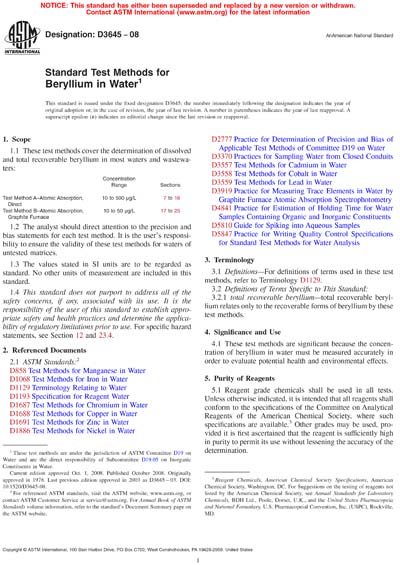Historical
ASTM D3645-08
Standard Test Methods for Beryllium in Water
1.1 These test methods cover the determination of dissolved and total recoverable beryllium in most waters and wastewaters:
| Concentration Range | Sections | |
| Test Method A–Atomic Absorption, Direct | 10 to 500 μg/L | 7 to 16 |
| Test Method B–Atomic Absorption, Graphite Furnace | 10 to 50 μg/L | 17 to 25 |
1.2 The analyst should direct attention to the precision and bias statements for each test method. It is the user's responsibility to ensure the validity of these test methods for waters of untested matrices.
1.3 The values stated in SI units are to be regarded as standard. No other units of measurement are included in this standard.
1.4 This standard does not purport to address all of the safety concerns, if any, associated with its use. It is the responsibility of the user of this standard to establish appropriate safety and health practices and determine the applicability of regulatory limitations prior to use. For specific hazard statements, see Section 12 and 23.4. 7.1 This test method is applicable in the range from 10 to 500 μg/L of beryllium. The range may be extended upward by dilution of the sample. 7.2 The precision and bias data were obtained on reagent water, tap water, salt water, river water, lake water, spring water, and untreated wastewater. The information on precision and bias may not apply to other waters. It is the user's responsibility to ensure the validity of this test method for waters of untested matrices. 17.1 This test method covers the determination of dissolved and total recoverable beryllium in most waters and wastewaters. 17.2 This test method is applicable in the range from 10 to 50 μg/L of beryllium using a 20-μL injection. The range can be increased or decreased by varying the volume of sample injected or the instrumental settings. High concentrations may be diluted but preferably should be analyzed by direct-aspiration atomic-absorption spectrophotometry. 17.3 This test method has been used successfully with reagent water, lake water, river water, well water, filtered tap water, and a condensate from a medium Btu coal gasification process. It is the user's responsibility to ensure validity of this test method to waters of untested matrices. 17.4 The analyst is encouraged to consult Practice D 3919
ASTM International [astm]

